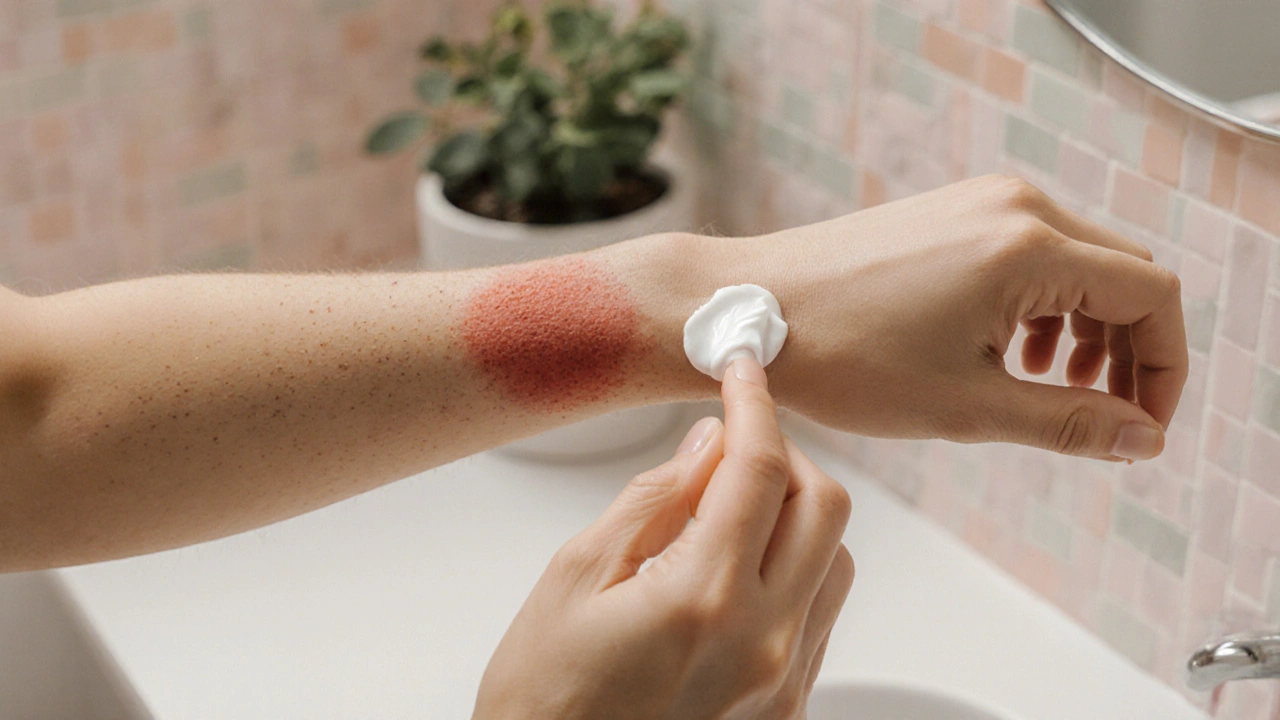How Contact Dermatitis Links to Eczema, Psoriasis & More
 Sep, 29 2025
Sep, 29 2025
Skin Condition Overlap Quiz
This quiz helps you understand how contact dermatitis relates to other common skin conditions like eczema and psoriasis.
1. What is the primary cause of irritant contact dermatitis?
2. Which skin condition is characterized by a broken skin barrier due to filaggrin loss?
3. What immune mechanism is involved in allergic contact dermatitis?
4. Why is it important to patch-test new skincare products?
TL;DR:
- Contact dermatitis is an inflammation caused by irritants or allergens that touch the skin.
- It often shares a broken skin barrier and immune triggers with eczema, psoriasis, acne and other rashes.
- Knowing the overlap helps you pick the right creams, avoid triggers, and know when to get medical help.
- Simple daily habits - gentle cleansing, moisturising, and patch‑testing - can keep flare‑ups at bay.
- If symptoms spread, persist, or you develop fever, see a dermatologist promptly.
What is Contact Dermatitis is an itchy, red skin reaction that occurs when the skin comes into direct contact with an irritant or an allergen?
When a substance like nickel, cleaning chemicals, or even certain plants touches your skin, it can trigger an inflammatory response. The skin may become red, swollen, blistered, or cracked. Two main sub‑types exist: Irritant Contact Dermatitis - caused by direct damage from harsh chemicals or friction, and Allergic Contact Dermatitis, which involves the immune system reacting to a previously sensitised allergen.
Both sub‑types share a common pathway: they damage the skin’s protective barrier, allowing water loss and inviting microbes. This barrier breach is the thread that ties contact dermatitis to many other skin conditions.
How does it differ from, and relate to, other common skin conditions?
Below is a quick side‑by‑side look at the key features of contact dermatitis versus a handful of well‑known skin disorders.
| Condition | Primary Trigger | Typical Appearance | Barrier Involvement | Immune Mechanism |
|---|---|---|---|---|
| Contact Dermatitis | Irritant or allergen contact (nickel, detergents, latex) | Red, itchy patches; sometimes blisters or scaling | Direct damage to stratum corneum | Innate irritation or Type IV hypersensitivity |
| Eczema (Atopic Dermatitis) is a chronic, relapsing rash driven by genetics and environmental factors | Genetic predisposition, dry skin, allergens, stress | Dry, scaly, intensely itchy plaques, often in flexures | Chronically impaired barrier, low filaggrin | Mixed Th2/Th1 immune response |
| Psoriasis is an autoimmune condition that speeds up skin cell turnover | Genetic factors, stress, infections, certain meds | Well‑defined, silvery‑scale plaques, often on elbows/knees | Hyper‑proliferative barrier, altered keratinocyte maturation | Th17‑driven inflammation |
| Acne Vulgaris is a disorder of the pilosebaceous unit characterised by comedones and inflamed lesions | Hormonal shifts, excess oil, bacteria, dead skin cells | Whiteheads, blackheads, papules, pustules, sometimes cysts | Follicular plugging; altered barrier within pores | Mixed innate and adaptive response, Propionibacterium acnes involvement |
| Seborrheic Dermatitis is a flaky, itchy rash commonly on the scalp and face | Malassezia yeast overgrowth, oil‑rich skin, stress | Yellowish‑white scales, erythema, often on eyebrows, nose, scalp | Barrier compromised by excess sebum and fungal metabolites | Innate immune reaction to yeast antigens |
Notice the recurring theme: a weakened barrier lets irritants, microbes, or allergens slip in, sparking inflammation. That’s why people with eczema or psoriasis often report flare‑ups after a contact dermatitis episode.
Shared Biological Pathways
Three core processes link these conditions:
- Barrier Dysfunction: Filaggrin loss (common in eczema) or over‑production of keratin (seen in psoriasis) reduces the skin’s ability to retain moisture. When the barrier cracks, even harmless substances become triggers.
- Immune Crosstalk: TypeIV hypersensitivity in allergic contact dermatitis can amplify existing Th2 or Th17 pathways, making an eczema or psoriasis patch itchier and more inflamed.
- Microbial Colonisation: Staphylococcus aureus loves the moist cracks left by contact dermatitis, just as it exacerbates eczema. Similarly, Malassezia yeast thrives in seborrheic dermatitis and can aggravate irritant reactions on the scalp.
Understanding these overlaps means you can treat multiple problems with a single strategy - for example, regular moisturising restores barrier fitness and often quiets both eczema and contact dermatitis.

When Conditions Overlap: Real‑World Scenarios
Imagine a gardener with a history of atopic dermatitis who suddenly develops a red, blistery rash after handling fertilizer. The irritant damage triggers contact dermatitis, but because their skin barrier is already compromised, the rash spreads faster and feels more intense than it would in a person without eczema.
Another common case: a teenager battling acne discovers that harsh acne‑spot treatments leave a thin, irritated strip of skin. That strip becomes a hotspot for allergic contact dermatitis to fragrance or preservatives in the product, producing a double‑layered rash.
These combos are not rare. Studies from dermatology clinics in Australia show that up to 30% of patients with chronic eczema experience at least one episode of contact dermatitis each year.
Practical Steps to Manage and Prevent Overlap
- Patch‑Test New Products: Apply a small amount on the inner forearm for 48hours. If redness or itching appears, discard the product.
- Choose Fragrance‑Free, Hypoallergenic Formulations: Look for labels that say “no added fragrance” and “dermatologist‑tested.”
- Moisturise Immediately After Washing: Use a thick, occlusive cream (e.g., petrolatum‑based) within three minutes of a shower to lock in moisture.
- Wear Protective Gear: Gloves for cleaning agents, long sleeves for gardening, and cotton‑lined socks for shoe wear can block irritants.
- Limit Scratching: Keep nails trimmed and use a cold compress to calm itch before it escalates to skin breakage.
- Consult a Dermatologist for Topical Steroids or Non‑Steroidal Anti‑Inflammatories: They can prescribe the right potency based on the area affected and whether you have eczema, psoriasis, or pure contact dermatitis.
By reinforcing the barrier and staying alert to new triggers, you reduce the chance that an irritant will snowball into a wider flare‑up across other skin conditions.
When to Seek Professional Help
If any of the following happen, book an appointment:
- Rash spreads to more than 30% of the body surface.
- Blisters burst, forming open sores that ooze.
- Fever, swollen lymph nodes, or joint pain accompany the skin changes.
- You have a known history of severe eczema or psoriasis and notice a sudden worsening.
- Over‑the‑counter creams provide no relief after a week of consistent use.
Dermatologists may run a patch test, take a skin biopsy, or prescribe systemic treatments like oral antihistamines, short‑course steroids, or newer biologic agents if the underlying condition (e.g., psoriasis) needs targeting.
Key Takeaway
While contact dermatitis can feel like an isolated reaction, it often rides on the same broken‑barrier and immune pathways that fuel eczema, psoriasis, acne, and other rashes. Treating the skin barrier, avoiding known triggers, and knowing when to get professional care can keep one condition from feeding the next.

Frequently Asked Questions
Can I have both allergic and irritant contact dermatitis at the same time?
Yes. Many people first develop irritant dermatitis from harsh chemicals, then become sensitised and later react allergic to the same or a different substance.
Is it safe to use the same moisturizer for eczema and contact dermatitis?
Most fragrance‑free, thick moisturisers work for both. Choose products that list simple ingredients like ceramides, glycerin, and petrolatum.
How long does a contact dermatitis flare usually last?
Mild cases often improve within 1‑2 weeks with proper care. Moderate to severe reactions may need a few weeks of topical steroids to fully resolve.
Can stress worsen contact dermatitis?
Stress can increase histamine release and weaken the skin barrier, making flare‑ups more likely, especially if you already have eczema or psoriasis.
Should I avoid all cosmetics if I have contact dermatitis?
Not necessarily. Opt for non‑comedogenic, fragrance‑free formulas and always patch‑test new products before full use.

Robert Frith
September 29, 2025 AT 20:01Blimey, this whole contact dermatitis rubbish is yet another proof that imported chemicals are sneakin’ onto our skin like invaders! We’ve got to stand up for our own brit‑skin and shut down the onslaught of harsh soaps, nickel, and all that foreign junk. Stop lettin’ the EU dictate what we put on our flesh, lad!
We need proper barriers, proper creams, and a proper pride in keepin’ our skin British!
Tim Moore
October 2, 2025 AT 03:34Thank you for the comprehensive exposition on the interrelation of contact dermatitis with eczema, psoriasis, and other dermatoses. Your elucidation of barrier dysfunction and immune crosstalk is both rigorous and accessible. It is commendable that you have included practical preventive measures alongside the pathophysiological discussion. Such balanced content serves to educate both clinicians and lay readers alike.
Erica Ardali
October 4, 2025 AT 11:08In the grand theater of epidermal drama, one must contemplate the ontological implications of a barrier breached. The skin, that fickle membrane, oscillates between protector and betrayer, echoing the existential duality of the self. To merely apply a moisturizer without reverence is to deny the profound symbiosis that underpins our corporeal existence. So let us not trivialize this cascade of immunologic whispers beneath the surface.
Justyne Walsh
October 6, 2025 AT 18:41Oh great, another article telling us to moisturise more-because apparently our skin is a thirsty desert that needs constant watering. As if we haven't been slathered in creams since the dawn of time, yet the market keeps churning out “new formulas” that do nothing but empty our wallets. Maybe the real irritant is the endless hype, not the nickel in our jewelry.
Callum Smyth
October 9, 2025 AT 02:14Hey folks, great info here! If you’re dealing with a flare, remember to keep your moisturizer on hand and apply it right after showering-this locks in hydration like a champion. 🛡️ Also, don’t underestimate the power of proper protective gear: gloves for cleaning, long sleeves for gardening-small steps, big difference. Keep at it, you’ve got this! 😊
Xing yu Tao
October 11, 2025 AT 09:48While your patriotic fervour is noted, the dermatological concerns transcend national boundaries and are rooted in universal human biology. The infiltration of irritants is a global issue, and the mitigation strategies you champion-such as barrier restoration-are indeed universally applicable. A collaborative approach, integrating both local practices and international research, will yield the most robust outcomes.
Adam Stewart
October 13, 2025 AT 17:21I appreciate your thoughtful analysis; it aligns well with evidence‑based practice and underscores the importance of interdisciplinary dialogue.
Selena Justin
October 16, 2025 AT 00:54Your detailed overview is both enlightening and considerate. It is reassuring to see such a balanced presentation that respects the complexities of dermatological care while offering actionable guidance. Thank you for fostering an environment of learning and empathy.
Freddy Torres
October 18, 2025 AT 08:28Patch‑testing: your skin’s secret handshake.
Andrew McKinnon
October 20, 2025 AT 16:01Indeed, the epidermal barrier dysfunction you describe is a classic case of immunologic over‑activation, a phenomenon we might label as “hyper‑reactive keratinocyte signaling.” Nevertheless, the practical implications remain straightforward: identify the allergen, implement barrier repair, and avoid unnecessary jargon that obscures patient compliance.
Dean Gill
October 22, 2025 AT 23:34When one examines the intricate cascade of events that follow a breach in the stratum corneum, the sheer complexity becomes apparent, and it is worth unpacking each step methodically. First, the disruption permits transepidermal water loss, which in turn triggers a compensatory hyperproliferative response from keratinocytes. Second, the exposure of intracellular proteins to the external milieu serves as a danger signal, recruiting innate immune cells such as dendritic cells and neutrophils. Third, cytokine release-including interleukin‑1, interleukin‑6, and tumor necrosis factor‑alpha-propagates the inflammatory milieu, bridging innate and adaptive immunity. Fourth, antigen‑presenting cells migrate to regional lymph nodes, where they prime naïve T cells, culminating in a type IV hypersensitivity reaction in the case of allergic contact dermatitis. Fifth, the resulting T‑cell mediated response amplifies local inflammation, often exacerbating pre‑existing conditions like atopic dermatitis or psoriasis. Sixth, the chronicity of inflammation can lead to epidermal remodeling, with changes in keratinocyte differentiation and increased expression of filaggrin‑degrading proteases. Seventh, this remodeling may perpetuate barrier dysfunction, creating a vicious cycle of irritation and immune activation. Eighth, therapeutic interventions-such as topical corticosteroids, calcineurin inhibitors, or barrier‑enhancing emollients-must be precisely timed to interrupt this cascade. Ninth, patient education on trigger avoidance and proper skin care regimens is essential to prevent recurrence. Tenth, regular follow‑up with a dermatologist ensures that treatment is tailored to the evolving clinical picture. Eleventh, emerging biologic therapies targeting specific cytokine pathways hold promise for refractory cases. Twelfth, however, the cost and accessibility of such treatments remain significant considerations. Thirteenth, research continues to elucidate the genetic predispositions that modulate individual susceptibility. Fourteenth, understanding these nuances empowers clinicians to adopt a personalized medicine approach. Fifteenth, ultimately, restoring barrier integrity and modulating immune responses represent the cornerstone of effective management for contact dermatitis and its overlapping dermatologic entities.
Royberto Spencer
October 25, 2025 AT 07:08The foregoing exposition, while exhaustive, gestures toward a deeper philosophical truth: the skin, as our most visible organ, reflects the paradox of human existence-simultaneously a shield and a vulnerable canvas. To neglect its integrity is to ignore the moral imperative of self‑care, a duty we owe not only to ourselves but to the community that witnesses our condition. Thus, let us champion both scientific rigor and ethical responsibility in our dermal stewardship.
Annette van Dijk-Leek
October 27, 2025 AT 14:41What an inspiring reminder!; indeed, caring for our skin aligns with broader ethical commitments; we must act with compassion, diligence, and humility; may we all remember that each moisturising act is a small but profound gesture of self‑respect!!!
Katherine M
October 29, 2025 AT 22:14Indeed, the intertwining of ethical duty and dermatological health forms a beautiful tapestry of holistic well‑being 🌿. By honoring our skin’s needs, we not only prevent disease but also embody a respect for the bodily vessel that carries our thoughts, emotions, and actions. Let us continue to integrate scientific insight with moral consciousness, fostering a community where knowledge and compassion coexist. 😊
Bernard Leach
November 1, 2025 AT 05:48Building on this synthesis of science and morality we see that the skin serves as a nexus between physiological processes and existential considerations the barrier function is a literal frontline in the body’s defense and a metaphorical boundary protecting personal identity therefore interventions must address both the molecular mechanisms of inflammation and the broader cultural narratives that shape individual health practices by aligning clinical protocols with ethical education we can create sustainable outcomes that respect both patient autonomy and communal well‑being